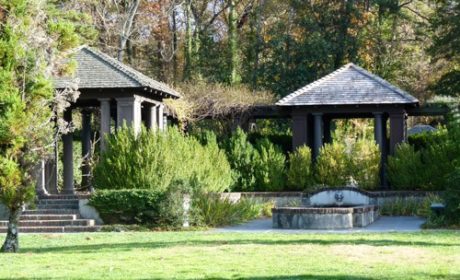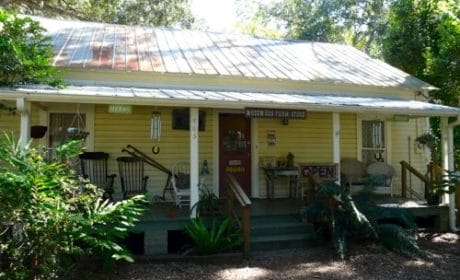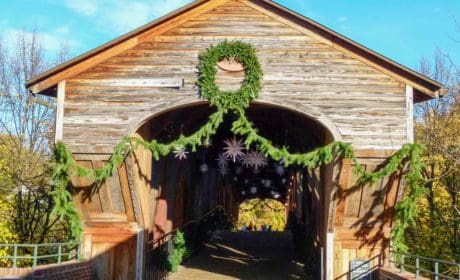USA travel is filled with all types of beautiful, historic, and quirky landmarks, from the vibrant city of Boston to the world’s largest ball of twine in Cawker City, Kansas. However, there are few sites that truly breathe history like Asheville, North Carolina’s extraordinary Biltmore House.
Guest writer, Vera Marie Badertscher from Ancestors in Aprons, takes us on a very unique tour of the opulent manor and its expansive grounds.
Visit Biltmore Estate for the forests (and the house)

Although I never could figure out what one would do with 250 rooms and 45 bathrooms, I have always wanted to see the largest private home in America: the Biltmore House near Asheville, North Carolina. Would it be just disgusting excesses of the Gilded Age? Weren’t those millionaires of the late 19th century all focused on making money without thought to others?
Inside the Vanderbilt’s home

My visit to the Vanderbilt estate provided a loud “NO” in reply to both those questions. The museum-worthy tapestry, paintings, drawings and furniture in the French Renaissance style Vanderbilt mansion have been chosen with care and are framed in rooms where colors and shapes are carefully coordinated.
Who could not warm to a man with 22,000 books in his library? I was impressed that his interior designer accompanied him to France so they could recreate a room from a chateau in which to hang his rare 16th century Flemish tapestries.
Unlike William Randolph Hearst of Hearst Castle fame, he was not dispatching agents to Europe to buy up the most expensive objects available. This was a man with a genuine knowledge and appreciation of the joys of great art. And great nature.
Boomer travel tip: Come back for a Biltmore House Christmas. The decorations are amazing!
The Birth of Forestry

The forested mountains of North Carolina drew Vanderbilt, who grew up in New York City. He built both this chateau and a forest retreat in the the state.
The United States once was covered with forests so thick that a squirrel, it was said, could travel across the state of Ohio without ever touching the ground. The landscape changed as people moved west.
In the 19th century, a few great men saw the value of restoring and preserving our native forests. They saw the danger of destroying one of our greatest natural resources. The purpose was and is to make timber perpetually available while still reaping the benefits of beautiful public natural spaces.

Surprisingly, we have a trio of wealthy members of the upper class plus a German forester to thank for National Forests. National Forest Preserves started in 1891, with the Shoshone near Yellowstone National Park,
But the training of foresters and the creation of the National Forest Service began here at the Vanderbilt-owned forest that became the Pisgah National Forest. When you camp, hike the trails, or pass through on a scenic drive, tip your hat to these forward-thinking men.

In 1889, George Vanderbilt hired Frederick Law Olmstead, creator of New York’s Central Park and the U.S. Capitol’s surroundings, to oversee the lands surrounding Biltmore House. Olmsted, the creator of outdoors vistas, must have salivated at the opportunity as he gazed at a scrubby and partly barren landscape that stretched for miles (125,000 acres) at the base of the Smoky Mountains.
Olmsted’s vision included restoring the forest surrounding the Biltmore Mansion and that meant planting thousands of trees. When you visit today you see green treetops in every direction.

With all those trees, the estate needed a full time forest manager. They hired George Pinchot.
No lowly lumberman engaged in tree cutting, Pinchot was a member of the elite class who later served as Chief of United States Forestry before being elected as Governor of Pennsylvania. By 1895, when Pinchot turned the reins over to his successor, Carl A. Schenck, trees covered 100,000 acres of Vanderbilt’s estate.
(For those of you interested, PBS is doing a documentary on Carl Schenck in 2016: First in Forestry.)
Visiting the Vanderbilt Forests today

A large portion of Vanderbilt’s forests makes up today’s Vanderbilt and Pisgah National Forests along the Blue Ridge Parkway in northwestern North Carolina. After only nineteen years enjoying the magnificent home he built, George Vanderbilt died in 1914, and his widow sold nearly 87,000 acres to the federal government. It is there that you can visit the Cradle of Forestry today.
Follow the Pisgah Highway, U.S. Rte. 276 on a very scenic detour from the Blue Ridge Parkway west of Asheville. On a recent road trip, following various byways in that part of North Carolina, we took this route past numerous waterfalls and a stop at Pink Beds, a place where pink mountain laurel and rhododendrons provide a glorious natural garden in the midst of forest.
Tips for a Biltmore House visit

The Biltmore Estate is still owned by family members and open to the public for a little over $64 a day (current price for 2020) if you buy in advance by phone or on the Internet. Extra activities like riding and fishing are also available.
You can take advantage of two hotels and more nearby and numerous restaurants on the property. The visit involves much walking and stair climbing, but there are trams in the summer for limited transportation.
I recommend setting aside at least a day to see the Estate, including a drive to Antler Village. I found the $10 for an audio tour of the house well worth the price for the additional tidbits about the man, the art, and the history of the estate.
After you leave Biltmore Estates, a drive on the Blue Ridge Parkway and nearby byways and picnicking in the National Forest may bring you back to reality for free. Thanks, George and Fred and George and Carl.
More things to do near the Biltmore Estate
- Enjoy an autumn escape to Hendersonville, North Carolina
- Go hiking on these easy trails in the Smoky Mountains



